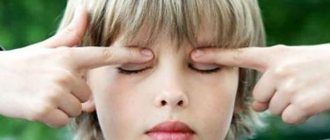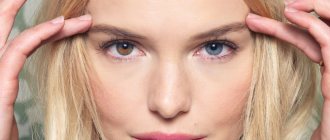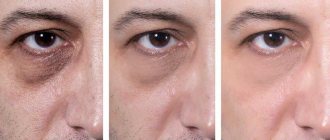Eye exercises are a simple method of preserving and restoring vision. Before performing a set of eye exercises, you need to take a little rest, relax, and not start immediately after working for many hours at the computer or after reading texts. And most importantly, you need to do such exercises regularly - especially against the background of drug treatment.
The basic rules for conducting such eye gymnastics are simple:
- Carry it out in the morning and evening - immediately after morning hygiene procedures and before bedtime
- Each exercise is done from 5 to 30 times, with a gradual increase in load
- Do not make sudden movements of the eyelids and eye muscles while performing the exercises.
- Exercise while removing lenses or glasses
- Between complex exercises, do simple, unloading ones, in the form of relaxed frequent blinking
"Beta version" of eye exercises
The main thing is to start. To do this, you can use a set of 5 simple, basic exercises. Which will relieve tension and develop the muscles of the eyeballs, eyelids, ciliary muscles that control the accommodation of the eyes (that is, they force the lens to work, changing its focal length depending on the distance to the object in question), and the radial and circular muscles of the iris, which contract or dilate the pupil .
- “Big eyes”: sit up straight, relax the neck-shoulder region, close your eyes tightly for 5 seconds, then open your eyes wide, as if in surprise, look at the world around you. Repeat at least 8 times. Exercise will help strengthen the muscles of the eyelids and improve their blood supply.
- "Massager." Clean, with soap, wash your hands. Relaxingly close your eyes, press with two or three fingertips on the lowered upper eyelids for 2 seconds. Do this at least 3 times. Exercise improves the circulation of intraocular fluids.
- "Drawing pictures." Close your eyes, relax and imagine any picture of any complexity. Hold it in front of you all the time, trying to examine and invent details.
- "We're watching the fly." Without turning your head, you imagined a fly flying in a circle in front of you. We follow her flight without taking our eyes off. The fly flies in front of you, first clockwise, then counterclockwise. Let's let an imaginary fly make three circles in one direction and the other.
- "Shooting range". “Shoot with your eyes” up, down, right, left. Mentally trace with your eyes a rhombus, a circle, a square, a bow, then often, often, like a butterfly with its wings, flapping your eyes.
Use the exercises as a basis, be sure to include them in a complex of any complexity. These 5 exercises are useful when working at a computer screen, or, which has become very rare, after proofreading texts in the library reading room. Reading exciting fiction also requires periodic rest for the eyes and the above exercises.
This kind of exercise for the eyes is especially relevant if the workplace (computer keyboard) is not well lit, or the general low level of illumination in the room contrasts sharply with a bright display.
Doctors' opinion
Doctors insist, and they are largely right, that eye exercises cannot cure astigmatism and other refractive errors. Official medicine does not recognize the position that the eye muscles are capable of changing the shape of the eyeball. Consequently, exercises aimed at strengthening them do not bring significant positive results. But the statement about the influence of muscles on the formation of the outlines of the eye, as well as the statement about “habitual tension” as the main factor that worsens the refraction of the eye, is the basis of Dr. Bates’ method.
Exercises do not provide such quick and tangible results as glasses, contacts or surgery (if indicated). However, some of the benefits of systematic “eye gymnastics” are not disputed, and its effects are considered deep and natural.
Maximum set of exercises
The following set of eye exercises has been developed both for people with normal vision, whose eyes experience significant visual stress, and for those with myopia and slight farsightedness, within the range of “+” or “-” 3.0 -3.5 diopters, without additional pathological visual lesions.
- Rapid, “burst” blinking for 2 minutes
- With your eyes closed, alternate between tightly closing your eyes and just relaxingly closed eyes. Periods of closing your eyes and relaxing are 5-6 seconds. The total duration of the exercise is 2 minutes.
- Standing directly in front of the window, attach a paper circle (preferably black) to the glass at eye level and fix your gaze on it. Then sharply move it to the farthest object outside the window, ideally located on the horizon, that is, at the conditional “infinity”. Look alternately at the circle and then at infinity for 10 seconds, repeating gaze shifts up to 10 times.
- With clean hands, massage the eyelids of closed eyes and their corners for 2-3 minutes, alternately for each eye separately.
- Stand up straight, raise your arms bent at the elbows in front of you. Begin to smoothly straighten your right hand, following with your eyes the tip of the extended index finger. Return your hand to its original position and begin doing the same with the other hand. Repeat 5-6 times.
- Close your eyes, and with cleanly washed hands, press the upper eyelid of your closed eye 7 times, alternately on the right and left. Pressing duration is 2 seconds.
- Standing straight, without moving your head and neck, take a quick look up at the ceiling. Then down to the floor, as close to your feet as possible. The exercise is repeated up to 10-12 times.
- Make a pendulum from available materials - in the form of a massive weight on a thread 70 cm long. Swing it in a plane perpendicular to the direction of your view. Watch the swing of the pendulum weight without taking your eyes off it for three to five minutes.
- LED Strip Light. The tape is attached in the form of a circle on the wall, and the “running lights” mode is set. Monitor the movement of the lights running along the tape for 3-5 minutes. The lighting in the room should not be too sparse; it is advisable to turn on ordinary evening room lighting for illumination and to avoid too much contrast between the running lights and the darkness.
How often should eye exercises be done at school?
So, physical exercises are an important element of a health-saving program. The teacher must organize lessons in such a way that children do not have time to get very tired. At the first lesson, physical education should be done after 20 minutes. It is better to interrupt the second and third lessons not once, but twice or three times - at the 10th, 15th and 20th minutes. The fourth lesson must necessarily include 3 minutes of rest. This will not take much time, and it will be much easier for both the children and the teacher.
Sets of exercises to restore vision
In case of myopia, especially a large degree, as well as a large amount of farsightedness, some, sometimes significant, amendments are made to the set of exercises.
Eye exercises for myopia
- Blink quickly and frequently for ½ minute. Give your eyes a minute break, close them and, relaxing, sit like that for about a minute. Blink again for half a minute - sit for a minute. Repeat this 4-5 times. Do not hurry. Relaxation between blinks should be complete; for this, it is best to sit in the “coachman’s pose” - on the edge of a chair, with your legs straight, knees bent at right angles, and relaxed palms on your knees. Shoulders down, back slightly bent.
- "Goggle". Alternately, close your eyes tightly for 10 seconds, then open them wide for the same time. Do 10-12 repetitions of this exercise.
- With cleanly washed hands, placing 2-3 fingers on each hand together into a “ruler”, press your drooping eyelids with them. You don’t need to press too hard, avoiding the appearance of luminous fog or flashing bright spots of color under your closed eyelids.
- Using your thumbs placed on your eyebrows, pull them up, while simultaneously resisting this action, lowering the direction of your gaze.
- Throw your head back and look down until your eyes feel achy and tired. Then lower your head with your chin on your chest and look up from under your brows until the same result is achieved. Repeat 8-10 times.
- Stand up to your full height. At a distance of 1-1.5 meters from you, under your feet, mentally draw a gradually expanding circular spiral on the floor. Follow its unwinding coils to its end, then also watch how it tapers towards the center. Do the exercise 3-4 times, depending on the “size” of this mental spiral.
For farsightedness
- Write letters with the tip of your nose. Better - not printed, but written, with their alternation of smooth and broken lines. You need to look at the tip of your nose. The time for writing letters is 10-12 seconds, then a half-minute break, and start all over again. Do 6-8 approaches.
- Having made a lattice from the fingers of both hands, try to examine objects located 10-20 cm away from you.
- Place a bright object measuring 20-30 cm at a distance of 3-4 meters from you. Stretch your hand forward, smoothly move your gaze from the object to the palm of your hand.
Therapeutic exercises for astigmatism
- Attach a sheet of paper the size of a standard Whatman paper to the wall. Draw a circle or a slightly elongated oval on its surface with a contrasting marker. Stand a meter and a half away from him and run your eyes along the line of the circle (or oval), without looking up, first clockwise, then counterclockwise. With pauses of 10-12 seconds. Repeat the exercise 3-4 times.
- Mentally draw crosses, triangles, squares. Run your eyes over them, abruptly changing the direction of your gaze. Use only straight lines for this.
- Exercise with an assistant: while remaining motionless, so that only the eye muscles work, ask someone, holding a pen or pencil vertically at a distance of a meter from you, to quickly move it left and right, up and down. Do not change the position of your head and body!
Exercises for strabismus
Strabismus, or strabismus , cannot be treated by therapeutic exercises in itself. It is treated with special glasses in which the lenses are adjusted, deviating the optical axis of the glasses from the true one. Eye exercises serve as an additional factor stimulating recovery.
- The starting position is the fingertip on the tip of the nose. Lift your finger from your nose and move it upward until your arm is fully straightened. The task is to follow the fingertip with your eyes without looking away. Then return your finger to your nose. Repeat the exercise 4-5 times
- Move your eyeballs up and down, left and right, without changing the position of your head, 5-6 times. After each such approach, close your eyes for half a minute, without squeezing them shut, but keeping them relaxed.
- Close your good eye. Looking at some object with a sideways eye, turn your head towards the affected eye, without letting the object out of the direct field of vision. If both eyes are squinting, do this exercise in turn for each.
- Close the healthy eye and begin to quickly move the patient in different directions for half a minute. Let rest for a minute. Repeat the exercise, and so on 4-5 times.
Additional Tips
The optimal time for eye exercises for adults is 10-15 minutes in total. For children - 5-8 minutes.
In clear weather, on a white sand beach, in sunny weather in winter with freshly fallen snow, and especially in the mountains, wear sunglasses.
We advise you to read: Principles of eye gymnastics according to Avetisov.
A good additional exercise for all types of eye pathologies (as well as for energizing healthy eyes) can be the use of a “bunny” from a switched-on laser pointer. Just don’t move the beam along the walls, ceiling or floor too quickly so that your eyes don’t get too tired while tracking the “bunny”. And do not allow the beam to hit mirror surfaces so that the laser beam can be reflected and enter the eyes - this can cause damage to the retina!
Gymnastics for glaucoma
Gymnastics for a diagnosis of glaucoma usually requires, in addition to drug treatment, exercises that will help improve the circulation of intraocular fluids.
- Focus your eyes on your fingers placed in front of you at a distance of half a meter. Begin to spread these fingers apart in a V shape, without losing focus on the point approximately between them.
- Standing about two meters from the window, focus your eyes first on the finger stretched out in front of you, then on the handle for closing the window, then on a leaf of wood located about 5 meters outside the window, then on the horizon. Carry out the steps in reverse order, returning to the finger on your outstretched arm.
- With your head stationary, move your eyes left and right, limiting your viewing sector to the line of your nose (approximately 90⁰).
A separate exercise for eye accommodation
- Sit in front of a table, the opposite edge of which is about a meter away from you, and the nearest one is 20-25 cm. The height of the eyes above the table is 30-40 cm.
- Take a rope or flexible cable 4-5 meters long, crumple it to form a shapeless, but not very tangled, ball, throw it on the table so that it occupies the entire area to the opposite edge of the table.
- Try to make the loops of the ball lie in the direction to the right and left, from you to you.
- The two opposite ends of the rope/cable should protrude freely from the ball in any place.
- Without changing the posture or position of your head, without moving it, try to trace all the intricacies of the ball along its entire length.
- The exercise is done for speed; the faster you accurately track all the loops and changes in direction, the better.
- After each pass, you need to rest your eyes for 30-40 seconds.
Rules for conducting classes
As the professor advises in his lessons, you should never start wearing glasses or contacts. This leads to muscle deformation and significantly impairs vision. In addition, you should spend more time in the fresh air and give access to sunlight. Try to limit your use of sunglasses. If your eyes get very tired, do the palming exercise for five minutes. When performing classes, consider the following rules:
- All exercises are performed without glasses or lenses.
- You should not make sudden movements; gymnastics should proceed smoothly.
- In case of severe farsightedness or nearsightedness, exercises are performed no more than four times. For retinal detachment only once.
Exercises should also be performed when your eyes are tired from working at the computer or reading a book. Take a break from your work and trace the following movements with your gaze:
- From bottom to top and back.
- From left to right.
- Diagonally from one corner to another.
- Square.
- Cross lines.
- Circle.
- Zigzag.
- Horizontal and vertical spiral.
After light gymnastics, you can begin Zhdanov’s main training to improve vision.
The rules are elementary:
- While taking the Zhdanov course, you must stop wearing vision-correcting devices - glasses and lenses.
- When performing exercises, the muscles of the whole body should be as relaxed as possible.
- It is extremely important not to rush, to do everything consistently and at a measured pace. A workout carried out in tension and haste will be ineffective.
- It is also important to stop drinking alcohol and smoking during active treatment.
- Overeating is also an enemy of vision restoration according to Zhdanov.
- During the entire recovery period, it is very advisable to constantly monitor your general psycho-emotional state. Nervousness and stress will actively inhibit the positive dynamics of the treatment process.
DETAILS: Sample menu for pancreatitis of the pancreas (diet 5)
If you follow these recommendations and perform high-quality, systematic exercises, the eye muscles will noticeably strengthen and become more plastic and flexible. Blood circulation in the eyeball will improve, while its trophism will stabilize. The flow of oxygen, minerals and biologically active substances into the organ of vision will also increase.
Attention. If, after performing the exercises, spots, spots in the eyes, headaches or any other unpleasant symptoms appear, then the number of repetitions should be reduced.
Prevention of vision using the Zhdanov method
The professor always follows simple rules. The main thing is to give your eyes rest when they are tired. Before meals, do exercises for the eye muscles three times a day. Avoid glasses and contact lenses completely. According to Zhdanov, they are shackles for the eyes, so he recommends wearing even sunglasses only in case of urgent need.
For people whose vision is fine and to improve vision, the professor’s advice is to perform simple exercises, for example:
- always give your eyes a rest when constantly working at the computer;
- take a ten-minute break every hour;
- at the moment when very tired eyes need to rest, use “Palming”;
- in your free time, “draw in your head” geometric shapes (squares, rectangles, spirals);
- blink your eyelashes frequently once a day, this will prevent “wet eye syndrome” and dryness;
- consume more foods that contain vitamin A (carrots, sprouted wheat grains, blueberries);
- carry out solarization - treatment with the sun or a candle (exercises cannot be done in bright light);
- close each eye in turn and hold for 5 seconds.
In addition to the above tips, Vladimir Georgievich recommends leading a healthy lifestyle and eliminating bad habits. Find peace of mind and peacefulness.
Causes of visual impairment in children and adolescents
Vision decreases for the following reasons in adults and adolescents with:
- Constant fatigue of the visual apparatus;
- Immune system failures;
- Poor nutrition and modern bad habits;
- Disturbed day and night mode;
- Acquired eye pathologies;
- Excessive workloads;
- Disorders of the nervous and endocrine systems.
Children's eye problems are felt from the first days of birth. Most often, a child needs special exercises due to:
- Birth trauma;
- Prematurity;
- Congenital defect;
- Heredity.
It is possible for children to have worsened vision because of:
- Head and spinal column injuries;
- Osteochondrosis;
- Regular stress;
- Hypertension;
- Long-term viewing of cartoons, games on smartphones and PCs.
It is the last point that is the main lever for the deterioration of the eye condition even before school. And the main features are:
- Frequent headache;
- Instant fatigue;
- Discomfort even with light loads.
For your information! Most often, children with poor vision simply squint. And it’s time to choose the right exercise or treatment.
Separate nutrition according to Zhdanov
Vladimir Georgievich is known among adherents of healthy eating. He developed a system in the form of separate food combinations. Conventionally divided into three groups: proteins, carbohydrates and “live food”. The first group includes meat products, the second - fruits and vegetables, the third - grain products (bread, bran).
The method is suitable for people involved in sports, following a diet, and will also help remove waste and toxins from the body. The fractional system allows you to look great and is combined with vision restoration techniques. Zhdanov advises at the stage of treatment of the visual system to give up fat, maintain separate meals, and drink plenty of water.
Zhdanov urges not only to eat properly and sparingly. As a student and follower of the folk healer Porfiry Ivanov, he calls for fasting days and observing Orthodox fasts (“cleanse the body and soul”). By following simple rules, V. G. Zhdanov claims that it is possible to restore not only vision, but also peace of mind.










